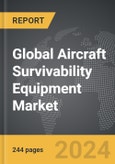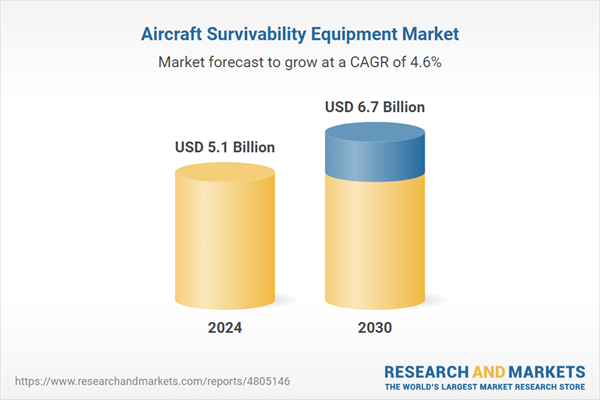The global market for Aircraft Survivability Equipment was valued at US$5.1 Billion in 2024 and is projected to reach US$6.7 Billion by 2030, growing at a CAGR of 4.6% from 2024 to 2030. This comprehensive report provides an in-depth analysis of market trends, drivers, and forecasts, helping you make informed business decisions. The report includes the most recent global tariff developments and how they impact the Aircraft Survivability Equipment market.
Segments: Platform (Combat Helicopter, Combat Aircraft, Special Mission Aircraft, UAVs); Subsystem (Electronic Support, Electronic Attack, Non-Combat Systems).
Geographic Regions/Countries: World; United States; Canada; Japan; China; Europe (France; Germany; Italy; United Kingdom; and Rest of Europe); Asia-Pacific; Rest of World.
The analysts continuously track trade developments worldwide, drawing insights from leading global economists and over 200 industry and policy institutions, including think tanks, trade organizations, and national economic advisory bodies. This intelligence is integrated into forecasting models to provide timely, data-driven analysis of emerging risks and opportunities.
Global Aircraft Survivability Equipment Market - Key Trends and Drivers Summarized
Why Is Aircraft Survivability Equipment Crucial in Modern Warfare?
Aircraft survivability equipment (ASE) plays a pivotal role in modern warfare by ensuring the safety and operational effectiveness of military aircraft in hostile environments. This specialized equipment encompasses a range of technologies designed to detect, avoid, and counter threats such as missiles, radar systems, and hostile aircraft. Key components include radar warning receivers, missile approach warning systems, infrared countermeasures, and electronic warfare suites. These systems work in concert to provide comprehensive situational awareness and defensive capabilities, enabling aircraft to complete their missions while minimizing the risk of being shot down. As adversaries continue to develop more sophisticated anti-aircraft systems, the importance of robust ASE cannot be overstated.How Are Technological Advancements Enhancing Aircraft Survivability Equipment?
Technological advancements are at the forefront of enhancing aircraft survivability equipment, making it more effective and reliable in diverse combat scenarios. The integration of artificial intelligence (AI) and machine learning is revolutionizing ASE by enabling real-time threat analysis and adaptive response strategies. Modern systems can quickly identify and categorize threats, allowing for more precise and timely countermeasures. Additionally, advancements in sensor technology are improving the detection capabilities of ASE, with more sensitive and accurate sensors providing better situational awareness. The development of directed energy weapons, such as laser-based countermeasures, represents another significant leap forward, offering the potential to neutralize threats at the speed of light. These technological innovations are critical in maintaining the edge over increasingly sophisticated adversarial threats.What Market Trends Are Shaping the Future of Aircraft Survivability Equipment?
The aircraft survivability equipment market is being shaped by several key trends that reflect the evolving nature of modern warfare and defense strategies. One major trend is the increasing focus on multi-domain operations, where ASE must be capable of functioning effectively in air, space, and cyber environments. The rise of unmanned aerial vehicles (UAVs) is also driving demand for advanced survivability solutions tailored to these platforms. Another significant trend is the shift towards modular and scalable ASE systems, which allow for easier upgrades and customization to meet specific mission requirements. The growing emphasis on interoperability is pushing manufacturers to develop ASE that can seamlessly integrate with various platforms and systems used by allied forces. Additionally, the proliferation of asymmetric warfare tactics, where non-state actors employ unconventional methods to challenge conventional forces, is underscoring the need for adaptable and resilient ASE.What Factors Are Driving Growth in the Aircraft Survivability Equipment Market?
The growth in the aircraft survivability equipment market is driven by several factors. Technological advancements, such as the integration of AI and machine learning, are propelling the development of more sophisticated and responsive ASE systems. The increasing complexity of modern combat environments, including the rise of electronic and cyber warfare, is creating a demand for more advanced and versatile survivability solutions. The expansion of global defense budgets, particularly in response to escalating geopolitical tensions, is fueling investments in cutting-edge ASE. Regulatory requirements for enhanced safety and operational readiness are also significant drivers, as they necessitate the adoption of high-performance survivability equipment. Furthermore, the trend towards multi-domain operations and the need for interoperability are pushing defense forces to invest in ASE that can operate seamlessly across different platforms and environments. The rise of UAVs and the need for specialized survivability solutions for these platforms are contributing to market growth as well. Lastly, the increasing prevalence of asymmetric threats is driving the demand for adaptable and resilient ASE to counter diverse and evolving challenges.Report Scope
The report analyzes the Aircraft Survivability Equipment market, presented in terms of units. The analysis covers the key segments and geographic regions outlined below.Segments: Platform (Combat Helicopter, Combat Aircraft, Special Mission Aircraft, UAVs); Subsystem (Electronic Support, Electronic Attack, Non-Combat Systems).
Geographic Regions/Countries: World; United States; Canada; Japan; China; Europe (France; Germany; Italy; United Kingdom; and Rest of Europe); Asia-Pacific; Rest of World.
Key Insights:
- Market Growth: Understand the significant growth trajectory of the Combat Helicopter Platform segment, which is expected to reach US$2.6 Billion by 2030 with a CAGR of a 4.2%. The Combat Aircraft Platform segment is also set to grow at 4.5% CAGR over the analysis period.
- Regional Analysis: Gain insights into the U.S. market, valued at $1.4 Billion in 2024, and China, forecasted to grow at an impressive 4.5% CAGR to reach $1.1 Billion by 2030. Discover growth trends in other key regions, including Japan, Canada, Germany, and the Asia-Pacific.
Why You Should Buy This Report:
- Detailed Market Analysis: Access a thorough analysis of the Global Aircraft Survivability Equipment Market, covering all major geographic regions and market segments.
- Competitive Insights: Get an overview of the competitive landscape, including the market presence of major players across different geographies.
- Future Trends and Drivers: Understand the key trends and drivers shaping the future of the Global Aircraft Survivability Equipment Market.
- Actionable Insights: Benefit from actionable insights that can help you identify new revenue opportunities and make strategic business decisions.
Key Questions Answered:
- How is the Global Aircraft Survivability Equipment Market expected to evolve by 2030?
- What are the main drivers and restraints affecting the market?
- Which market segments will grow the most over the forecast period?
- How will market shares for different regions and segments change by 2030?
- Who are the leading players in the market, and what are their prospects?
Report Features:
- Comprehensive Market Data: Independent analysis of annual sales and market forecasts in US$ Million from 2024 to 2030.
- In-Depth Regional Analysis: Detailed insights into key markets, including the U.S., China, Japan, Canada, Europe, Asia-Pacific, Latin America, Middle East, and Africa.
- Company Profiles: Coverage of players such as Aselsan A.S., BAE Systems PLC, Chemring Group PLC, Elbit Systems Ltd., Israel Aerospace Industries (IAI) and more.
- Complimentary Updates: Receive free report updates for one year to keep you informed of the latest market developments.
Some of the 42 companies featured in this Aircraft Survivability Equipment market report include:
- Aselsan A.S.
- BAE Systems PLC
- Chemring Group PLC
- Elbit Systems Ltd.
- Israel Aerospace Industries (IAI)
- Northrop Grumman Corporation
- Raytheon Company
- RUAG Holding AG
- SAAB AB
- Terma A/S
- Thales Group
Tariff Impact Analysis: Key Insights for 2025
Global tariff negotiations across 180+ countries are reshaping supply chains, costs, and competitiveness. This report reflects the latest developments as of April 2025 and incorporates forward-looking insights into the market outlook.The analysts continuously track trade developments worldwide, drawing insights from leading global economists and over 200 industry and policy institutions, including think tanks, trade organizations, and national economic advisory bodies. This intelligence is integrated into forecasting models to provide timely, data-driven analysis of emerging risks and opportunities.
What’s Included in This Edition:
- Tariff-adjusted market forecasts by region and segment
- Analysis of cost and supply chain implications by sourcing and trade exposure
- Strategic insights into geographic shifts
Buyers receive a free July 2025 update with:
- Finalized tariff impacts and new trade agreement effects
- Updated projections reflecting global sourcing and cost shifts
- Expanded country-specific coverage across the industry
Table of Contents
I. METHODOLOGYII. EXECUTIVE SUMMARY2. FOCUS ON SELECT PLAYERSIII. MARKET ANALYSISIV. COMPETITION
1. MARKET OVERVIEW
3. MARKET TRENDS & DRIVERS
4. GLOBAL MARKET PERSPECTIVE
UNITED STATES
CANADA
JAPAN
CHINA
EUROPE
FRANCE
GERMANY
ITALY
UNITED KINGDOM
REST OF EUROPE
ASIA-PACIFIC
REST OF WORLD
Companies Mentioned (Partial List)
A selection of companies mentioned in this report includes, but is not limited to:
- Aselsan A.S.
- BAE Systems PLC
- Chemring Group PLC
- Elbit Systems Ltd.
- Israel Aerospace Industries (IAI)
- Northrop Grumman Corporation
- Raytheon Company
- RUAG Holding AG
- SAAB AB
- Terma A/S
- Thales Group
Table Information
| Report Attribute | Details |
|---|---|
| No. of Pages | 244 |
| Published | April 2025 |
| Forecast Period | 2024 - 2030 |
| Estimated Market Value ( USD | $ 5.1 Billion |
| Forecasted Market Value ( USD | $ 6.7 Billion |
| Compound Annual Growth Rate | 4.6% |
| Regions Covered | Global |









